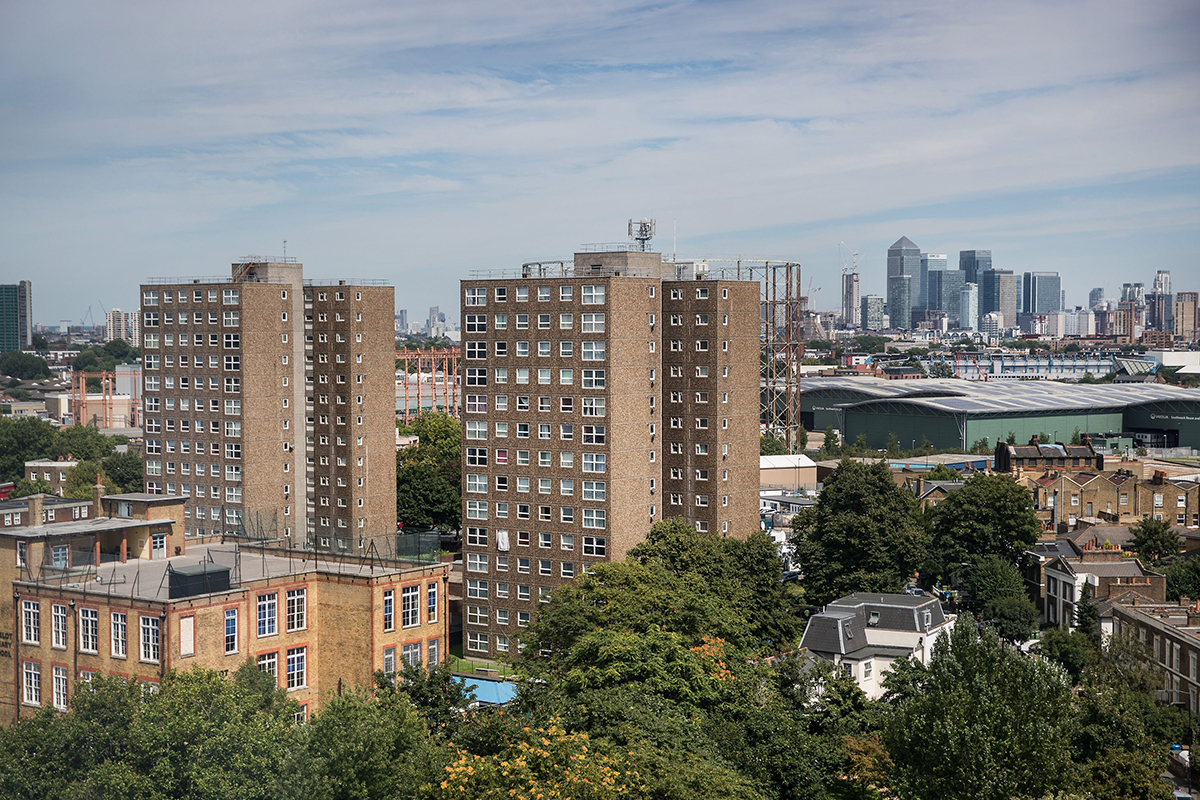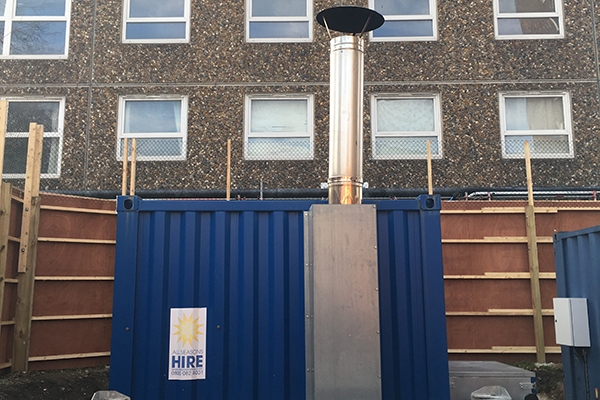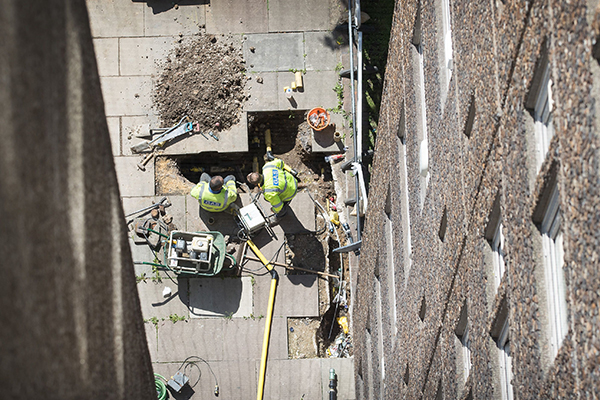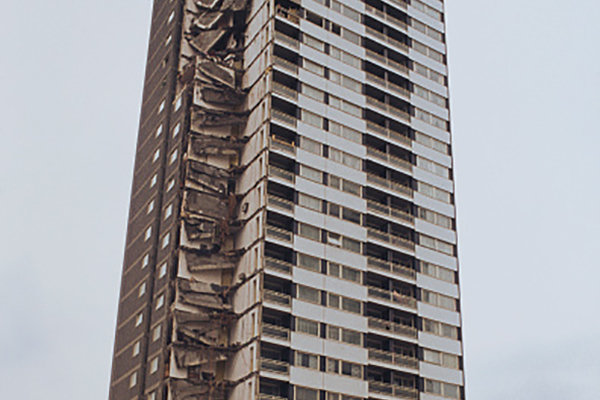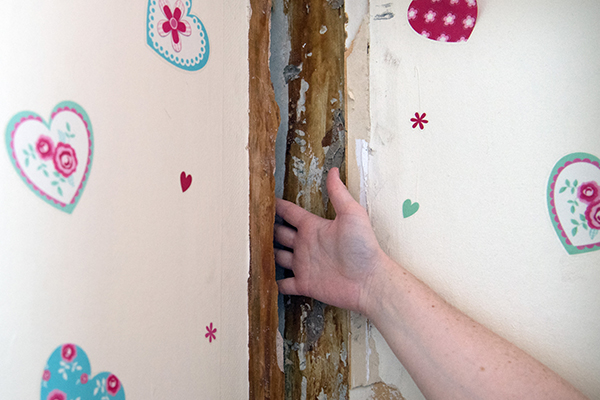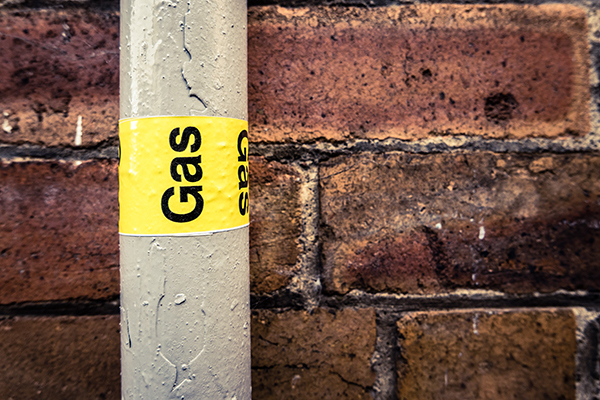You are viewing 1 of your 1 free articles
The Ledbury Estate building safety scare - what happened next?
Three months after Southwark Council removed the gas supply from four blocks due to the risk of collapse, Sophie Barnes finds out what has been going on since. Photography by Getty, Rex Features and Sophie Barnes
In August, the four tower blocks which make up the Ledbury Estate were stripped of their gas supply after experts warned they were at risk of partly collapsing in the event of a gas explosion. This left residents without heating or hot water, and the colder months were fast approaching.
Three months later, Inside Housing takes a look at what has been done to keep residents warm, why the estate was left with a potentially dangerous gas supply for nearly 50 years after a fatal accident at a nearby tower block and what lessons landlords of similar buildings could take from Ledbury.
The Ledbury Estate has four large panel system tower blocks. While not the catchiest of names, large panel system (LPS) blocks came under scrutiny back in the late 1960s when an LPS block in Newham – Ronan Point – partially collapsed due to a gas explosion, killing four people.
Shortly after the disaster, the government ordered all landlords of LPS blocks to either remove the gas supply from the blocks or carry out strengthening work.
Ledbury Estate residents had been reporting cracks in the walls of their flats and leaks – common issues in LPS blocks, according to experts, and a danger because cracks can breach the fire safety of the buildings. It was only in July, at a Southwark Council meeting to discuss the problems, when independent consultant Arnold Tarling warned the council that the blocks’ gas supply was not safe – 49 years after the Ronan Point collapse. It became clear the blocks had been at risk in the event of a gas explosion for years.
The council asked engineering consultancy Arup to investigate and it came back with the worrying conclusion that it could not guarantee the safety of the blocks with a gas supply fitted.
As soon as Arup gave the council their findings, the gas supply was switched off, sparking a speedy search for an alternative heating system that would be safe for the blocks.
Gas company employees work to cut off the gas to the tower blocks on the Ledbury Estate
The prospect of coming up with a whole new heating-system solution in less than a month was a daunting task for the council’s engineering staff.
Tony Hunter, head of engineering at the council, was all too aware of the need for urgency. “The gas was switched off on 11 August and at that time of year you’re starting to think it’s not going to be too long before it’s winter. So we were thinking, ‘Right, we’re going to need to get heating and hot water very quickly, and we’re going to need some kind of heating and hot water solution for the interim because people are without both.’”
The council decided on a traditional district heating system – a central boiler providing heat and water to a number of properties. Through some “intense planning”, the council came up with a solution that delivered temporary boilers at the base of each block, with gas taken by pipework into the block, up an existing duct, then into every property.
“The gas was switched off on 11 August and you’re starting to think it’s not long before winter.”
Thomas and Frances Ennis, a retired couple who are leaseholders, moved into the estate just over a year ago after coming over from Dublin. Their main concern was whether or not they would lose their kitchen which they have lovingly done up – complete with gleaming red wall tiles and a five-ring hob. But they were impressed with how hard the council’s engineering staff worked to find a solution that would mean their kitchen didn’t have to be torn out to fit a new heating interface unit.
“All our concerns and worries at the beginning were about, ‘Are we going to have to lose our kitchen?’ but what amazed us was how accessible the council people were at all levels, and how willing they were to come into our flat,” says Mr Ennis.
Ronan Point tower block in Canning Town, east London, in May 1968
Mr Hunter is proud of the speed at which the work was completed, particularly as the council aren’t aware of any other social landlord who has had to carry out such a large overhaul of a heating system within such a short space of time.
All the residents Inside Housing spoke to are impressed with how quickly the council installed the new system. Similarly, residents only have warm words about the council staff who have taken up residence in their local Tenants’ and Residents’ Association hall, who are on site 24 hours a day, seven days a week, to answer residents’ queries.
But there are still questions over how the blocks were left with a potentially dangerous gas supply for so many years. It’s not clear why the blocks weren’t strengthened after the Ronan Point disaster, as directed by government, because the council doesn’t have any records for the estate dating back to when it was built.
Back then, the Ledbury Estate was owned by the Greater London Council (GLC), since dissolved. Stephanie Cryan, Southwark’s deputy leader and cabinet member for housing, says: “I suspect the people who made those decisions are either long retired or no longer with us. The GLC records are very patchy and sketchy.”
Danielle Gregory, who helped set up the Ledbury Action Group which has raised concerns over the safety of the blocks, says unless the council looks into how the handover from the GLC to Southwark Council was handled, “no lessons will be learned from this”. She adds: “We could have learned lessons from the Packington Estate, which is another LPS estate. There’s obviously a problem with large panel systems, so we should lead the way.”
A significant crack in the wall of a resident’s flat
Residents are also critical of the council’s approach to dealing with cracks and leaks across the buildings that have been an ongoing issue for years. Some residents have spotted cracks wide enough to fit a fist through.
Daniella Gomez lives in Bromyard House with her one-year-old daughter, Antonella. “For me, it’s been quite a roller coaster, stressful time,” she says. “I’m quite an anxious person and you can visibly see those cracks. They’re everywhere in every room. I was feeling anxious – what would I do if a fire happened, thinking about my baby, seeing reports about Grenfell Tower. It doesn’t feel like home to me any more, and I’ve lived here for 20 years.”
“There’s obviously a problem with large panel systems, so we should lead the way.”
Resident Glenn Holmes reported a crack in the wall of his flat a year after he moved in, 16 years ago. He says other residents have reported cracks from when they moved in during the early 1970s. When it comes to the leaks Mr Holmes says “loads of flats have had them for years and it’s always dealt with individually”.
The council’s overview and scrutiny committee will now commission an independent report looking at when the cracks and leaks were reported and what action was taken by the council, to address the residents’ concerns.
Ms Cryan is clear that the cracks “have always been there, so the risk of breaching compartmentation has always been there. I guess what the audit will look at is has anybody ever looked at it, has it been reported, and, if so, how it’s been dealt with.”
New heating system at Ledbury Estate
Residents have been told they can move out of the estate permanently if they wish, and the council will give them a £6,100 payment to cover the move. There are 29 households who have moved out of the blocks already and 21 others have accepted new accommodation offers.
It’s not yet clear what the future is for the estate. A report from Arup concluded that the blocks are in “good condition” structurally, but strengthening work is required to provide “sufficient resistance against disproportionate collapse”. The council has said it will bring in an independent consultant to draw up options with the help of a panel of residents.
Ms Cryan has said various options will be put to residents, but “whatever those options are, we know that residents will have to move out, either temporarily or permanently”.
The council had previously given residents a “100% guarantee” that they will have the right to return to their homes once work is completed, so it’s unclear how this fits with the potential prospect of having to move out permanently.
Ms Cryan says other social landlords with LPS blocks should take a close look at what they own.
“I worry about blocks like this across the country. I grew up in an LPS tower block, and I look back on it and think, ‘Oh my God, what about where I grew up? What if I was at risk?’ There is a lesson which the government needs to look at, working with other authorities. It’s got to be more than writing a letter.”
Ledbury Estate building safety scare: a timeline
4 July 2017: Inside Housing reports Southwark Council is carrying out urgent inspections of tower blocks on the Ledbury Estate after residents reported cracks
10 August 2017: The council confirms it has switched off the gas supply and says it will decant the blocks, with tenants are offered cash to fund moves out of the affected blocks
15 August 2017: Southwark Council leader Peter John says tenants will not be forced ot move out temporarily in the short term
31 August 2017: A council-commissioned report by engineering consultancy Arup finds a gas explosion at Ledbury could cause “a disproportionate collapse” similar to the 1968 Ronan Point disaster
6 September 2017: Inside Housing reports that residents of the Ledbury Estate are taking legal action against Southwark Council
7 September 2017: The government writes to social landlords to tell them to take action to seal any cracks found in large panel system blocks
21 September 2017: Residents protest over the continued lack of heating in the Ledbury Estate blocks following the withdrawal of the gas supply
21 November 2017: A fresh report by Arup finds “no deterioration” in the blocks
28 November 2017: Southwark Council introduces an immediate evacuation policy after fire safety breaches were found
